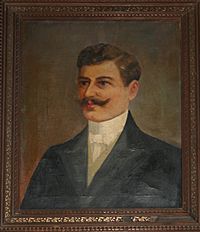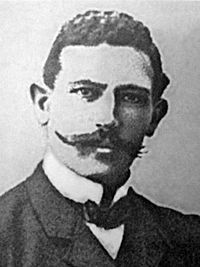Mirko and Stjepan Seljan facts for kids
Mirko Seljan (born April 5, 1871) and Stjepan Seljan (born August 19, 1875) were famous Croatian explorers. They traveled across Africa and South America, mapping new areas and meeting different cultures. Mirko disappeared around 1913, and Stjepan passed away in 1936.
Contents
Early Life of the Seljan Brothers
The Seljan brothers were born in Karlovac, a city in Croatia. At that time, Croatia was part of a larger country called Austria-Hungary. After finishing their basic schooling, they began traveling all over Europe.
Mirko, the older brother, became quite famous in 1898. He was known as the "Champion Globetrotter" because he walked a very long distance. He walked all the way from Paris, France, to Saint Petersburg in Russia! It is thought that the brothers were inspired to explore after reading books or hearing talks by another Croatian explorer, Dragutin Lerman. Lerman had been part of Henry Morton Stanley's team in Africa.
Stjepan Seljan's birth name was actually Štefan. Later in his life, people often called him Stevo.
Adventures in Africa
In January 1899, the brothers started their big adventure. They left Karlovac and traveled to Trieste, which is now in Italy. From there, they visited cities like Alexandria and Cairo in Egypt. They even walked along the famous Nile River towards Sudan.
After returning to Cairo, they continued their journey. They went to Port Said, Djibouti, and Aden, reaching a narrow sea passage called Bab el Mandeb. Their travels eventually led them to Harar and Addis Ababa in Ethiopia.
Working with the Emperor
In Ethiopia, the Seljan brothers met Menelik II, who was the Emperor of Ethiopia. Because of good recommendations from other Europeans, the Emperor gave them a large group of 300 people to help them continue their journey south.
Mirko was given an important job: he became the governor of a southern province in Ethiopia. His brother Stjepan became his assistant, known as the lieutenant-governor. For three years, they worked to draw the border between Ethiopia and Kenya. They also helped bring different tribes under the Emperor Menelik II's rule. Their camps near Lake Turkana were even named Seljanville. You can still see these names on maps today!
Their journey greatly helped Ethiopia. They expanded Ethiopia's control to the right side of the Omo River. The borders we see today between Ethiopia, Sudan, and Kenya around Lake Turkana are very similar to the ones the Seljan brothers helped create. They left in 1902 because of political problems but returned later.
Emperor Menelik II respected them very much. He gave them many gifts. Some of these gifts are still with their families today, while others are on display at the Ethnographic Museum in Zagreb, Croatia. The brothers' travels were sometimes affected by world politics, but their main goal was always to learn new things and understand the world better.
Exploring South America
In April 1903, the Seljan brothers set off for Rio de Janeiro in Brazil. They wanted to explore parts of the country that were still unknown. Their goal was to create new travel and trade routes and set up permanent posts. The Brazilian government was interested in their work because they wanted to improve trade and development from the east to the west.
Mapping and Missions
In 1903, they started the Croatian Scientific Mission. They met the Guaraní tribe near the Aguapehu River and carefully mapped the area. By the end of 1903, they were traveling from Salta Grande to Asunción, the capital of Paraguay. Their journey ended on the Paraná River in Argentina. Their adventures from this time are described in a book published in 1905 in Buenos Aires. In 1905, they visited the amazing Iguaçu waterfalls and later did research for the state of Santa Catarina.
New Expeditions and Challenges
At the beginning of 1905, the Seljans crossed the Andes mountains on foot and with mules, arriving in Chile. In cities like Valparaíso and Santiago, they planned a new expedition. They wanted to reach the Amazon River area from the south. Here, they met Croatian immigrants and formed a group called the Slavic Society for the Exploration of Mato Grosso. This group was meant to help support their expeditions.
In May of that year, they went to Montevideo, Uruguay, with a new friend and explorer named Franjo Pommer. They started their expedition later, in 1908, focusing on the Rio Branco and Rio Maracá rivers in the Amazon delta. They became tired and frustrated by delays in getting permits from the government. So, they returned to Chile, hoping to explore Peru and Bolivia. In 1911, they explored the Atacama desert and the Tarapacá area. That year, they entered Peru for the first time. They even started a "Croatian Brokerage Society" to help the Peruvian government plan and build roads connecting different parts of the country, from the Andes to the Amazon basin.
The End of Their Journeys
In October 1912, the brothers went their separate ways for the first time. Stjepan headed to the United States to start new business deals. Mirko was supposed to continue their research and begin a new expedition. However, his group did not meet up with another group of explorers as planned.
Mirko decided to go deeper into the rainforest on his own, near the Huayabamba River. After that, he was never seen again. Many ideas about what happened to him came up, but none were ever proven.
After his older brother disappeared, Stjepan continued to travel. He searched for valuable minerals in South and Central America. In 1917, he decided to settle down and made his home in Ouro Preto, Brazil. He lived there until he passed away in 1936.
Why They Explored
The Seljan brothers' journeys were sometimes affected by world politics and the new industrial society of their time. However, they made many important observations during their travels. They collected information that was later used in studies about landforms (geomorphology), weather (climatology), and different cultures (ethnography).
Their main goal was to make their own lives richer and to add new knowledge and understanding to the world. In their diaries, they wrote about the places they visited. They described the Indigenous tribes they met and left behind many sketches, photographs, maps, and memories about the nature and cultures they enjoyed discovering.



